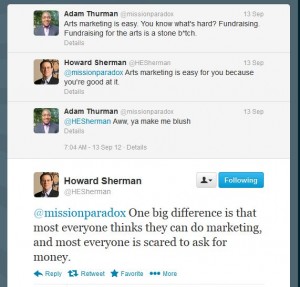The approach of the holidays provides me with a little more free time so I have been catching up on my “come back to and read” list. I got to reading a piece by Non-Profit Law blogger, Emily Chan addressing activities athletic booster clubs engage in that may endanger their non-profit status.
Since these clubs are organized under 501 (c) (3) just like arts organizations, I became a little concerned because I see similar things happening with some arts organizations.
The potential conflict Chan addresses is in making the amount of money a person raises directly correlate with the benefit to an individual like crediting against the payment of tuition/dues or travel expenses.
Furthermore, such a credit system still raises private benefit concerns regardless of whether a parent is considered an insider or even involved in the booster club. Lois Lerner, the Director of Exempt Organizations at the Internal Revenue Service, recently affirmed that crediting amounts raised by a participant against that participant’s costs (e.g., dues, travel expenses) is a private benefit violation that may jeopardize the organization’s exempt status.
What immediately came to mind is that a lot of dance schools have their students sell tickets, Entertainment coupon books, etc., keep track of what each person sells and rewards the kids. I don’t think there is any problem with one child only getting to choose glitter stickers because she sold less than the child who was able to claim a stuffed animal.
However, if those sales determined who got to perform or helped one person defray more of the cost of going to see a show in New York than another, there could be a problem. If it defrays the cost of everyone equally, or even a specific class within the group like sending the cast of a show to perform at a festival, then it isn’t problematic.
Really, it is mostly a matter of benefits specific to individuals. This also likely includes fund raising to benefit a specific individual, say the medical expenses of a musician who was in a car crash.
Individuals should not be soliciting contributions from donors with any suggestion or intention that the contribution will be directly used for that individual who solicited the gift. Additionally, the booster club should not accept any contributions that have been earmarked by the donor for a particular individual. Not only would such contributions not be tax-deductible for the donor, the booster club would likely be acting as a conduit in violation of the federal tax laws regulating private inurement and private benefit by allowing such money to pass through the organization to the individual without having exercised any control, oversight, or discretion over those funds
I wonder how this might apply to organizations that try to forge a deeper connection with donors by having them sponsor a student. Keeping in mind that I am not a lawyer, my guess is that if the organization is selecting the student being sponsored, there isn’t a problem. The money went into a general pot with no specific expectation of which student would benefit.
But what happens if the student drops out and the donor has taken a shine to another student and wants the sponsorship applied to her as a replacement? This is a tricky situation if you are hoping for the long term, continued support of the donor.
I also wonder if something changes with the student’s status that requires more funding than for any other student, say their place of residence changes so they must pay higher out of state tuition, can the donor be solicited or even direct additional money to benefit a specific student without endangering the non profit tax status?




Thanks for what you are doing to bring cultural change to the arts. It is so important to represent everyone.…